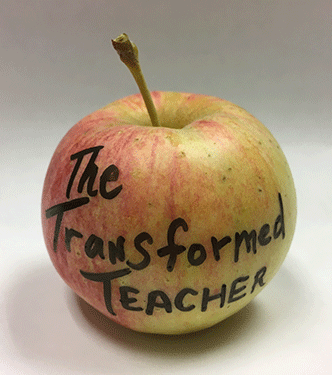THE TRANSFORMED TEACHER – Avoiding workplace burnout: the essential tool

*Although faculty on <12-month appointments technically have time off, we all know there’s a double standard. Plus, it’s extremely difficult to get any other work done while you’re teaching. And then there are our colleagues who have 12-month appointments. They work full time, 40+ hours a week, the entire summer.
Regardless, after submitting grades I’m switching gears. I’m NOT going to think about teaching for weeks (months). I might even take a… what’s that called again… I don’t quite remember because it’s been so long…
Oh yes, that’s right – a HOLIDAY!
(Silent boogie in my office akin to the Harlem Shake) (Baauer 2012, NPR 2013)
Burnout, a workplace epidemic.
Overwhelm and burnout are a real hazards, especially in academia. To quote Sherrie Bourg Carter in Psychology Today, burnout is a ‘state of chronic stress’ and can lead to:
- Physical and emotional exhaustion
- Cynicism and detachment
- Feelings of ineffectiveness and lack of accomplishment
Watch for warning signs (chronic fatigue, sleep problems, forgetfulness, impaired concentration and attention, physical aches and pains, loss of appetite, getting sick more often, anxiety, depression, and anger).
Has your interest and enthusiasm tanked? Feeling unengaged, dispirited, and on the verge?
You’re not alone. There are a slew of articles about burnout in academia, including:
- ‘The 40-year-old burnout: why I gave up tenure for a yet-to-be-determined career’ by Jonathan Malesic
- ‘Why I collapsed on the job’ by Katerina Bodovski
- ‘Faculty burnout has both external and internal sources, scholar says’ by Audrey Williams June
- ‘Avoiding burnout in the new academic year’ by Jason B. Jones
- ‘Four ideas for avoiding faculty burnout’ by David Gooblar
-
 CC0
CC0
It’s important to note that faculty are not the only ones who suffer – administrators, staff, and students also experience burnout. This is a good post for students: ‘Four risk factors for burnout – and how to overcome them’ by Tchiki Davis.
Burnout can also lead to absenteeism and presenteeism. The former is defined as a “chronic absence, as from work or school” (Merriam-Webster 2018) and can have serious consequences (like getting fired). Dr. Janie Crosmer, whose research focused on faculty burnout, defines presenteeism as being physically present but mentally checked-out (June 2010, Stripling 2010). You’re doing your job and checking those boxes, but the reality is you’re going through the motions.
Presenteeism: doing your job, but being mentally checked out and simply going through the motions
R3 (Rest, Relaxation, and Really-just-do-it!)
Burnout is a complex issue and may not have a simple fix. Acting before your flame flickers is the best case scenario.
Suggestions to reduce burnout span institutional, departmental, and individual boundaries. Here are just a few examples from June 2010, Davis 2016, and Gooblar 2018:
- Policies and practices that support a healthy work-life balance.
- Treat people with respect and acknowledging their value.
- Create departments with collectivistic values. (Translation – a greater emphasis on community where faculty can share or trade workloads as needed / appropriate)
- Practice self-care. You are not a machine. And quit comparing yourself to others. You are unique. This is fantastic, as diversity is good (Page 2007).
One tip that comes up over and over again?
Take a break.
I know it seems impossible because our work NEVER ENDS. EVER. I get that. Prioritize yourself.
Take a break anyway.
I promise you, the world won’t collapse. Things won’t fall apart. Everything will be fine. Better than fine. The time is now.
Unplug. Unwind. Have downtime.
Vacation? Stay-cation? Taking the afternoon off? Free time can come in many forms – it doesn’t need to be fancy. But it is vital. Recharge your batteries and you’ll step back into the classroom with renewed energy. It’s just what the Ph.D. ordered.
Chin up!
The Transformed Teacher

The Transformed Teacher is a faculty member who took a bold step out from behind highly detailed lecture notes and a gigantic podium into the teaching-verse, which is a magical place filled with helpful tips, tools, and teachers.
As I learn more about teaching, I find I’m significantly better than I was before, and a lot less neurotic. In fact, sometimes teaching is downright fun. Imagine that.
REFERENCES:
Baauer (Harry Bauer Rodrigues). 2012. “Harlem Shake.” Harlem Shake – single. Released May 22, 2012. Mad Decent, Jeffree’s.
Davis T. 2016. Four risk factors for burnout – and how to overcome them. April 21 2016. Greater Good Magazine, UC Berkeley. https://greatergood.berkeley.edu/article/item/four_risk_factors_for_burnoutand_how_to_overcome_them
Gooblar D. 2018. 3 ways colleges can help faculty members avoid burnout. April 17, 2018. The Chronicle of Higher Education. https://www.chronicle.com/article/3-Ways-Colleges-Can-Help/243134
June AW 2010. Faculty burnout has both external and internal sources, scholar says. June 9, 2010. The Chronicle of Higher Education. https://www.chronicle.com/article/Faculty-Burnout-Has-Both/65843
Merriam-Webster. 2018. Absenteeism. Merriam-Webster online dictionary. https://www.merriam-webster.com/dictionary/absenteeism
NPR Staff. 2013. Where does the Harlem Shake actually come from? February 21, 2013. National Public Radio, All Things Considered. https://www.npr.org/2013/02/21/172615268/where-does-the-harlem-shake-actually-come-from
Page SE. 2007. The difference: how the power of diversity creates better groups, firms, schools, and societies. Princeton University Press, NJ. https://books.google.com/books?id=hJRu4O8q1xwC&printsec=frontcover#v=onepage&q&f=false
Stripling J. 2010. Burning out, and fading away. June 10, 2010. Inside Higher Ed. https://www.insidehighered.com/news/2010/06/10/burning-out-and-fading-away
Check out my previous posts:
How to make a mountain into a molehill
Self-growth in academia: support sandwich evolution
Group work (pt. 2): What’s in a name?
Top 10 list for day 1
3 nuggets of wisdom for dealing with end-of-semester ‘feedback.’
5 steps to changing behavior.
Stuck in the middle (of the semester) with me.
Group work (pt. 1): Let’s get real.
Justifying just makes life easier.
Say something. Anything. Please…?
Changing educational pain to pleasure.